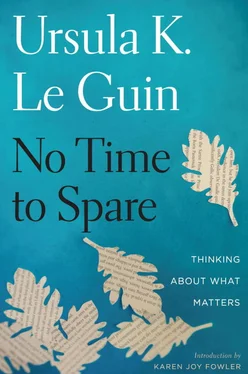The snake continued to look at me only and I at it only, while Denys set the garbage can down on its side with the opening facing the snake, maybe twenty feet from it and very visible to it. Then, coming quietly round behind it at full tube-length, he flicked the end of the tube near its head. That broke the spell. I looked away from the snake at the tube, the snake looked away from me at the tube, and then flowed hurriedly away from the thing flicking about in the air behind it and made straight for the welcoming dark cave of the garbage can. It flowed right into it—at which Charles ran to upend the can, and clapped the lid on.
A mighty and wrathful commotion took place inside the can. It shivered and trembled and all but danced. We stood in awe and listened to the rage of a truly angry rattlesnake in an echo chamber. It finally quieted down.
“Now what?”
“Anywhere a good ways away from the house.”
“There’s the millionaire up at the end of the road,” said Denys. “I’ve turned several snakes loose up there.”
A pleasing thought. The millionaire was never there, nobody lived on his lovely hilltop. Excellent rattlesnake territory. The three humans and the garbage can all got in the car and drove up the road, the snake in the can making some vicious criticisms in a low, hissing buzz along the way. At the end of the road we got out and laid the can down, knocked the lid off with the invaluable plastic tube, and watched the split-second disappearance of the snake into a thousand acres of wild oats.
It was our garbage can, the one that still stands up at the top of the driveway where the garbage company can collect on Mondays. I have never looked at that can since, in all these years, without thinking of what it held, once.
A teaching, a blessing, may come in strange ways, ways we do not expect, or control, or welcome, or understand. We are left to think it over.
November 2010
LAST WEEK MY friend Roger and I went out to Bend, the eastern Oregon city where a lot of retired people in search of sunlight and a dry climate have been settling since the 1990s. From Portland the shortest road is over Mount Hood and through the vast Warm Springs Reservation. It was a bright late October day, with the big broadleaf maples making masses of pure gold in the evergreen forests. The blue of the sky got more intense as we went down from the summit into the clear air and open landscapes of Oregon’s dry side.
Bend is named, I guess, for the bend of its lively river in which it sits. The Three Sisters and other snow cones of the Cascades tower up over it in the west, and the vast expanses of the high desert sweep on out eastward. In recent years the city grew and thrived with the influx of settlers, but it hit hard times with the recession. Too much of its prosperity depended on the construction trades. Downtown is still pleasant, but there are gaps, with several fine restaurants gone, and it looks as if some new resorts out toward Mount Bachelor are paralyzed at the platting stage.
We stayed at a motel there on the west side of the river, which is built up at intervals, with bits of juniper forest and sagebrush plain in between. The long, wide boulevards go winding around in curves, crisscrossing each other at three- and four-exit roundabouts. It appears that the people who laid out the roads wanted to imitate what happens when you drop noodles on the floor. Though Tina at Camalli Books had given us careful instructions with all the road names and all the roundabout exits on the way to and from our motel—and though a western skyline of six- to ten-thousand-foot mountain peaks would seem to provide adequate orientation—we never once left the motel without getting lost.
I learned to dread the Old Mill District. As soon as I saw the sign saying OLD MILL DISTRICT I knew we were lost again. If Bend were a big city instead of just a far-flung one we might still be there trying to escape from the Old Mill District.
Roger and I were there to do a reading and signing of our book Out Here at the bookstore Friday evening and at the High Desert Museum Saturday afternoon. The museum is on Highway 97 a few miles south of town. A bit farther on is Sunriver, one of the earliest and biggest resort developments. Roger suggested we have lunch there. Given the money that flows through those residential resorts, I was expecting something on the gourmet side; but the bar and grill served the same huge piles of heavy food that you get at a bar and grill anywhere in America, where the idea of a light lunch is a pound or two of nachos.
I haven’t stayed at Sunriver but have spent a few nights at other high-end resorts in the area. They are laid out artfully to blend into the austere and beautiful landscape. Built of wood and painted or stained in a repetitive range of muted colors, the houses are unobtrusive, with plenty of space around them and trees left standing between them. All the streets curve. Straight streets are anathema to the resort mind. Right angles say City, and resorts are busy saying Country, and that’s why all the boulevards west of the river loop and swoop about so gracefully like noodles. The trouble is, since the juniper trees and the sage bushes and the buildings and the streets and the boulevards all look pretty much alike, if you don’t remember just where Colorado Drive connects with Century Drive before the roundabout exit to Cascade Drive, if you don’t have a good inner or external GPS system, you get lost.
Staying a couple of years ago at one of these resorts in a granny flat in somebody’s condo, I could get lost within a hundred yards of the house. All the curvy streets and roads were lined with groups of houses in tasteful muted earth tones that exactly resembled the other groups of houses in tasteful muted earth tones, and there were no landmarks, and it all went on, over and over, sprawling out, without sidewalks—because of course the existence of such a place is predicated entirely on driving, on getting to it, from it, and around it by car. I don’t drive.
Bend is, I believe, the largest city in America with no public transportation system. They were fixing to do something about that when the bottom fell out of the building trade.
So after getting lost a couple of times walking, because I couldn’t tell which tastefully muted house on which curving road was my house, I was uneasy about going out again. But if granny didn’t go for a walk she was trapped in the granny flat. And that was pretty bad. When you first walked in, you thought, Oh! very nice!—because the whole inner wall was a mirror, which reflected the room and the big window, making it look large and light. In fact the room was so small it was almost entirely filled with bed.
The bed was piled with ornamental pillows. I counted them, but have forgotten how many there were—say twenty or twenty-five ornamental pillows, and four or five enormous teddy bears. When you took the bears and pillows off the bed so you could use the bed, there was no place to put them but on the floor around the bed, which meant there was no floor space, only pillows and bears. There was a tiny kitchen on the other side of a divider. No desk, no chair, though there was a blessed window seat to sit in, with a big view of trees and sky. I lived in the window seat, making my way through the bears and pillows when it was time for bed.
A door, which could not be locked, led down a corridor to the owners’ apartment, which was occupied. I put my suitcase and eight or ten of the pillows and the hugest, most obese teddy bear against the door as a barrier against absent-minded intrusion by my unknown hosts. But I didn’t have any real faith in that bear.
Roger and I kept passing that very resort on our noodly way to refinding our motel, and I winced every time I saw it, afraid we might somehow get into it and get lost in it again.
Читать дальше












